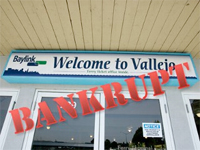 Somebody in a comment earlier this week said that I was especially turned off by unions in a post talking about California. Unions actually behave just the way that you would expect them to, to maximize their own power. The thing they are most interested in is not actually their member’s welfare but their own welfare; they would always prefer increases in the prison and education budgets to be taken as more people rather than higher salaries or higher productivity for the existing members, and we’ve certainly had a lot of that. The California democratic politicians, meanwhile, have gerrymandered themselves a permanent incumbent majority and they are supported by those same unions. So they go along with expansion of spending year after year, and expansion of salaries and, especially, benefits. Everyone gains except the private sector taxpayers, who get screwed.
Somebody in a comment earlier this week said that I was especially turned off by unions in a post talking about California. Unions actually behave just the way that you would expect them to, to maximize their own power. The thing they are most interested in is not actually their member’s welfare but their own welfare; they would always prefer increases in the prison and education budgets to be taken as more people rather than higher salaries or higher productivity for the existing members, and we’ve certainly had a lot of that. The California democratic politicians, meanwhile, have gerrymandered themselves a permanent incumbent majority and they are supported by those same unions. So they go along with expansion of spending year after year, and expansion of salaries and, especially, benefits. Everyone gains except the private sector taxpayers, who get screwed.
I’m not especially anti-union, but I think that the political-union complex is completely out of control, and is a major threat to Silicon Valley’s continued long-term success. We are on a path to private squalor and public affluence in California. The private sector will have to fund all the promises that the politicians made over the years, in a massive transfer of wealth from the poor (retirees living on their savings and people making average salaries) to the rich (public sector retirees).
The cities of Vallejo went bankrupt recently, entirely due to firefighter and police salaries and benefits, especially retirees where they have lots of retired employees on six-figure salaries and unlimited medical benefits for life. Vallejo has 120,000 residents but $850M of unfunded retiree commitments to the police and firefighters. That’s around $25,000 per household. Those people probably also owe at least that much in unfunded public sector retiree benefits at the state level too. Many other cities are predicted to go bankrupt in the current downturn, since it’s the only way they have a chance to re-negotiate those gold-plated contracts.
A friend of friend works in finance for the Santa Clara school district. Every teacher they employ costs $180,000 per year. About a third of that is salary and medical benefits but the rest is their retirement benefits, which Santa Clara is smart enough not to leave unfunded to create a future disaster. I wish someone was putting away over $100,000 per year for my retirement.
There’s not really any good way to measure prison guard productivity, but in education there is. Over the last 20 years, adjusted for inflation, California’s spending on education has doubled. But standards are exactly where they were 20 years ago according to the state’s tests. In what other industry has productivity halved? The best part of California’s education system is actually the universities and community colleges. But that part is now threatened because all the money is going to the inefficient K-12 segment where, in principle, we could cut spending by 50% with no effect on outcomes. Stanford is a private university, but Berkeley, UCLA and so on are not. If they lose their stars then it will certainly affect Silicon Valley.
Since Arnold Schwarzenegger was elected governor in 2003, California’s spending has increased by 40% because so much of the budget is on autopilot, driven by various propositions or by existing contracts. What that means is that we could reduce California’s budget by a bout a third and it would be something like 2001 again. It didn’t seem bad back then after all.
